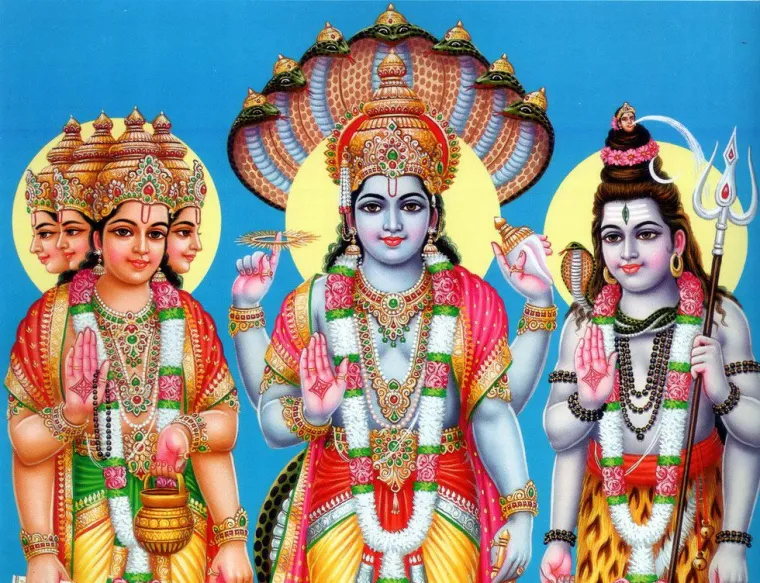Are you planning a pilgrimage to the birthplace of yoga? If so, then congratulations on taking steps towards what will undoubtedly be a life-changing experience!
Before you begin your sacred journey to India, it’s important to remember that the practice of yoga is the gift of ancient Hindus. And while yoga doesn’t require practitioners to adhere to a specific faith, Hinduism does remain the major religion in India with some 80% of the population identifying with the belief system.
That being so, knowing a bit about the Hindu deities will certainly enrich your pilgrimage to India. There are said to be 33 million gods in Hinduism symbolizing one abstract Supreme Being.
Brahma
The first deity of the Hindu trinity, Lord Brahma is considered to be the god of Creation, including the cosmos and all of its beings. Brahma also symbolizes the mind and intellect since he is the source of all knowledge necessary for the universe. Typically you’ll find Brahma depicted with four faces, which symbolize the completeness of his knowledge, as well as four hands that each represent an aspect of the human personality (mind, intellect, ego and consciousness).
Vishnu
The second deity of the Hindu trinity, Vishnu is the Preserver (of life). He is believed to sustain life through his adherence to principle, order, righteousness and truth. He also encourages his devotees to show kindness and compassion to all creatures. Vishnu is typically depicted with four arms to represent his omnipotence and omnipresence. It is also common to see Vishnu seated upon a coiled snake, symbolizing the ability to remain at peace in the face of fear or worry.
Shiva
The final deity of the Hindu trinity is Shiva, also known as the Destroyer. He is said to protect his followers from greed, lust and anger, as well as the illusion and ignorance that stand in the way of divine enlightenment. However, he is also considered to be responsible for the death, destroying in order to bring rebirth and new life. Shiva is often depicted with a serpent around his neck, which represents Kundalini, or life energy.
Ganesha
One of the most prevalent and best-known deities is Ganesha, easily recognized by his elephant head. Ganesha is said to bestow wisdom and good fortune, remove obstacles, and is associated with the arts and sciences. It is especially common to pray to Ganesha before any big venture, such as a wedding or new project. There are many myths and stories that explain how Ganesha came to have an elephant head, but it is typically thought that the humorous image stills the rational mind and its doubts while encouraging believers to look beyond outer appearances and form.
Hanuman
Another easily distinguishable god is Hanuman, the deity depicted as a monkey. Hanuman represents the ideal devotee of god and is worshipped as a symbol of strength, perseverance and devotion. Hanuman is often called upon in times of trouble as he teaches the unlimited power within each of us when we direct all of our energies to God, specifically shown in the epic tale Ramayana.
Krishna
Lord Krishna is one of the most powerful incarnations. He is kept very near to many Hindus’ hearts, as he is not only viewed as a hero and leader but also as a teacher and a friend. Krishna is said to be the embodiment of love and divine joy and destroyer of all pain and sins. If you have read the Bhagavad Gita then you are likely already familiar with Krishna as he is the main hero in the epic and has a lot to say about yoga, using the term over 100 times!
Kali
Perhaps one of the fiercest deities is Kali, also known as the Dark Mother. Kali is known for her tongue protruding from her mouth, her garland of skulls, and her skirt of bones. This is to symbolize the death of ego and remind worshippers that the human body is only a temporary condition. Contrary to what her image might suggest, she is not actually responsible for human mortality.
Rama
Rama is the model of reason and virtue and is often considered to be the ideal man due to his compassion, courage, devotion and adherence to dharma. His bow and arrow symbolize his readiness to destroy evil and protect righteousness. Rama is also known for his role as the protagonist in the Ramayana.
Saraswati
Saraswati is the goddess of learning, music, art and wisdom. She is typically worshipped when devotees desire knowledge or understanding. Most often she is pictured as a beautiful woman playing the lute, seated upon a white lotus or a swan.
Durga
The goddess Durga is an important representation of the Divine Mother, also known as ‘the Invincible’. She is said to protect mankind from evil and misery and does so as the destructive force of jealousy, prejudice, hatred and ego. Durga is depicted with eight arms holding a myriad of weapons to show that she is always protecting mankind in every direction of the world.
Keep your eyes and hearts open on your pilgrimage to India and you will encounter many of the above deities on your journey!
Article courtesy : Casey Siemasko
